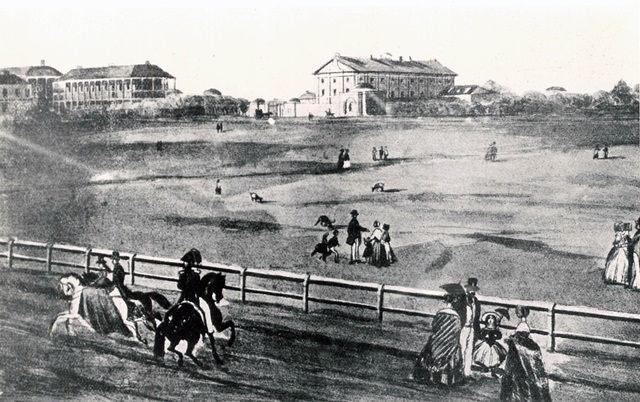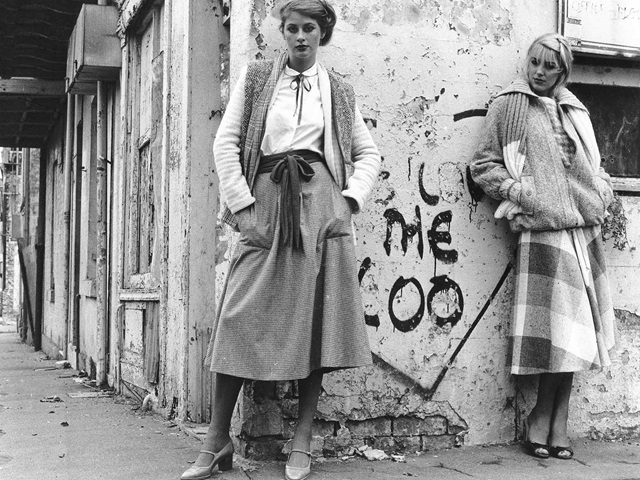History of Hyde Park
Australia’s oldest park came close to being sold in the 1830s.

Hyde Park is bounded by Elizabeth, Liverpool and College streets and Prince Albert Road in central Sydney.
It is in the area reserved by Governor Phillip in 1792 for the use of Sydney on an elevated and comparatively level site adjacent to the town, and is therefore Australia’s oldest park.
It was used as a common for gathering firewood and grazing animals until its proclamation by Governor Macquarie in 1810. He named it after the park in London.
Although architect Francis Greenway envisaged it as the grand quadrangle of a neo-classical town plan, Hyde Park’s first use was as a course for horse racing. By the 1820s it had become a popular venue for cricket matches and children’s games.



In the 1830s Governor Darling proposed to sell off the park for houses, but his successor Governor Bourke decided against this plan and re-affirmed its status as a park.
College Street was built in 1832 which divided off part of Hyde Park, in the area which became Cook + Phillip Park. In 1837 a new water supply known as Busby’s Bore brought water to Hyde Park where a raised pipe was used to fill the town’s water-carts.
With the building of Sydney College (1832), nearby Lyons Terrace (1841) and the Australian Museum (1849-51), the southern end of Hyde Park attracted significant and imposing buildings which increased its importance as a planned open space envisaged by Francis Greenway.
The park remained without grass or trees until 1854, when the Hyde Park Improvement Committee was established. The cricket ground was moved to the Domain and the park was formalised with paths and plantings. Civic monuments were also installed in the park. The first in 1857 was the obelisk facing Bathurst Street, which is actually a vent for the underground sewer.
A bronze statue of Queen Victoria’s husband, Prince Albert, was erected in 1866, 5 years after his death. This statue was moved to the Botanic Gardens in 1922 and was relocated in front of Hyde Park Barracks in 1987. Another statue, erected in 1879, depicts Captain James Cook.
During the 1850s, with the coming of responsible government, Hyde Park became a venue for Sunday oratory on political and civic topics, and later election meetings. It was also used for processions and official gatherings such as the ball to welcome Queen Victoria’s son in 1868. Its 19th century layout featured straight paths rather than curved ones, with the central avenue of Moreton Bay fig trees continuing the line of Macquarie Street. Elsewhere lawns were interspersed with clumps of trees and shrubs, water features and a bandstand.
The park was handed to Sydney City Council in 1904 and a program of upgrading began, but all this work was swept away with the coming of the city circle rail line in the 1920s. The whole park was dug up to build the lines, and St James and Museum stations were located within it. Work began in 1919 with the felling of the fig trees, and it was 1926 before reconstruction of the park could begin.
The 1926 design competition for Hyde Park was won by Norman Weekes, an engineer who was influenced by the City Beautiful movement. Weekes’s design was heavily modified by the assessment committee, although the basic work of importing fertile soil was the first priority.
As the re-establishment of the park began, its 2 major monuments were erected. At the northern end of the park the Archibald Fountain was completed and installed in 1932. The Anzac Memorial to Australia’s World War I soldiers opened in 1934 at the Liverpool Street end of the park.
In the 1950s, as the replanted trees matured, more changes were made to the park, with the demolition of the bandstand near the corner of Park and College streets and its replacement by the Sandringham Garden.
In 1964 the Nagoya Gardens were built at the northern end of the park, and the giant chess board near St James Station was installed in 1972.
Sculptures and memorials
YININMADYEMI Thou didst let fall
This prominent sculpture by Aboriginal artist Tony Albert aims to acknowledge and honour Aboriginal and Torres Strait Islander men and women who served in the nation's military. The artwork is composed of 4 standing bullets and 3 fallen shells. The arrangement of the bullets represents those who survived and those who were sacrificed, but also references the discrimination faced by Aboriginal and Torres Strait Islander soldiers when they returned to Australia.
Anzac Memorial and Pool of Reflection
Bruce Dellit designed this memorial to Australia’s World War I soldiers with sculptures by Rayner Hoff. It opened in 1934 and consists of an Art Deco ziggurat in red granite. In front of the memorial along the line of the park’s central avenue is the Pool of Reflection.
Emden Gun
This war trophy stands at the south-east corner of the park facing Oxford Street. It is a 4-inch naval gun from the German cruiser Emden which was sunk off the Cocos Islands by HMAS Sydney on 9 November 1914, the first Australian naval victory. It was installed in 1917.
Obelisk
The obelisk, irreverently known as “George Thornton’s scent bottle”, was erected in 1857 opposite Bathurst Street. It is an air outlet for the underground sewer cleverly disguised as a full-size replica of Cleopatra’s Needle, the Egyptian antiquity now displayed in London.
Captain Cook Statue
The statue of the English explorer of Australia’s east coast was erected in 1879 to mark the centenary of his death. It stands near the corner of Park and College streets, the highest point in the park. Its sculptor was Thomas Woolmer who was prominent in the English pre-Raphaelite movement and spent several years in Australia.
Frazer Fountain
This sandstone fountain on the College Street frontage opposite Sydney Grammar School is one of 2 donated by merchant and MLC John Frazer. It has been moved 3 times since it was first installed in the park in 1881.
Hyde Park Family Centre
Sydney’s first women’s public lavatory was built in 1910 in the park near the corner of Park and Elizabeth streets. It was considered a failure by the council due to low use and was replaced in 1955 by the Hyde Park Family Centre to provide facilities for visiting women and children including child care. The centre was demolished and the area grassed over in 2000.
Archibald Fountain
J F Archibald, founder of the Bulletin magazine who died in 1919, left money for a fountain to commemorate the association of France and Australia in World War I. The fountain was designed by François Sicard and completed in 1932.
Dalley Statue
This bronze statue stands at the northern end of the park near Prince Albert Road. It was erected by public subscription in 1897 to commemorate the populist politician William Bede Dalley (1831-1888).
Oddfellows Memorial
This elaborate drinking fountain commemorates members of the Grand United Order of Oddfellows who served and died in World War I. It stands on the corner of Park and Elizabeth streets.
Sandringham Garden
This terraced garden was designed by Ilmar Berzins, the first qualified landscape architect in Australia. It is a memorial to King George V and George VI and was opened by the Queen during her first visit to Australia in 1954. It is named after the Royal Family’s residence in Norfolk, England.
Walker Fountain
Erected in 1961 facing Elizabeth Street, this fountain was presented by the family of Frederic Joseph Walker to commemorate farming pioneers of Australia. It was sculpted by Gerard Havekes.
Further reading
Helen Proudfoot, Hyde Park Sydney: Statement of Significance and Historical Analysis, 1987
McDonald McPhee Pty Ltd, Hyde Park South Conservation Plans for Culturally Significant Items, 1990
Ian Kirk, Heritage Assessment Report and Heritage Impact Statement of Hyde Park Family Centre, 1999
DPWS Heritage Group, Anzac Memorial Proposed Vertical Lift Screens and Roof Repair Works: Heritage Impact Statement, 1999



